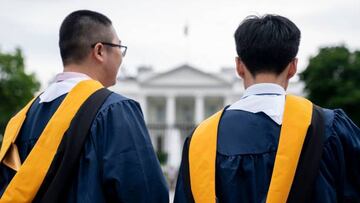Do both public and private universities offer financial aid?
Higher education in the US can be prohibitively expensive but there is financial support available for students in both public and private schools.

The cost of a college education seems to rise every year and getting a degree can be crucial for job prospects in a competitive work environment. The ever-growing price of higher education has led to a drop in higher education enrolment in recent years but millions of students still choose to take on the huge debts every year.
After the pandemic-induced disruption for colleges things are expected to return to normal this year with huge numbers of students likely to descend on campuses across the country. In 2019, the last year of college enrolment to be unaffected by the pandemic, there were roughly 14.5 million students enrolled in public universities and another 5.14 million in private universities.
There are more than 4,000 colleges across the US, so what are the difference between public and private schools, and how are they financed?
How does financial aid differ between public and private universities?
In 2019 it was found that the annual expense of a college education in the United States can reach as high as $75,000. The average is less than that figure but a study by Education Data Initiative found that the average cost for a single year of college, including tuition, books, supplies, and daily living expenses, is $35,331.
Both public and private schools offer some form of federal financial aid to students to help them cover the cost of their studies. To see what you could be entitled to, fill out your details at Free Application for Federal Student Aid, also known as FAFSA.
Students at public and private schools will have similar access to federal support, but students at private colleges are also more likely to benefit from grants and scholarships. Private institutions accrue sizeable endowment funds, essentially donations from individuals or organisations to support the college, which are often passed on to students.
Private colleges have great flexibility in their fees structure, meaning that they are better able to offer tuition discounts for select individuals. In 2020/21 the National Association of College and University Business Officers found that private colleges offered an average tuition discount of 48% to prospective undergraduates.
What types of financial aid are on offer?
College students can receive financial aid from federal and state authorities, and from private sources such as charities and benefactors. Some of the support needs to be paid back, often with interest, and some does not need to be repaid.
Here’s the five kinds of financial aid on offer for undergraduates:
Grants – Typically awarded based on the recipient’s needs, rather than on a merit-based system. Grants are allocated by federal and state governments and do not need to be repaid.
Scholarships – Much like the grants, scholarships do not need to be repaid. However scholarships are usually distributed in the form of a single lump sum. They can be merit-based or need-based and can be awarded by the college itself or in coalition with corporations, private entities, charitable organisations or professional associations.
Loans – Undergraduates often need to utilise either federal or private loans to cover the cost of college in the short-term, in the knowledge that they will have to be paid back in the future. Student loans must be used for expenses related to studies, like tuition fees and school supplies
Federal Work-Study – Students who need extra financial assistance can be given priority for certain part-time jobs, typically on-campus working in the university.
Fellowships and Assistantships – Generally reserved for graduate and postgraduate students, fellowships and assistantships allow recipients to work while continuing their education.






